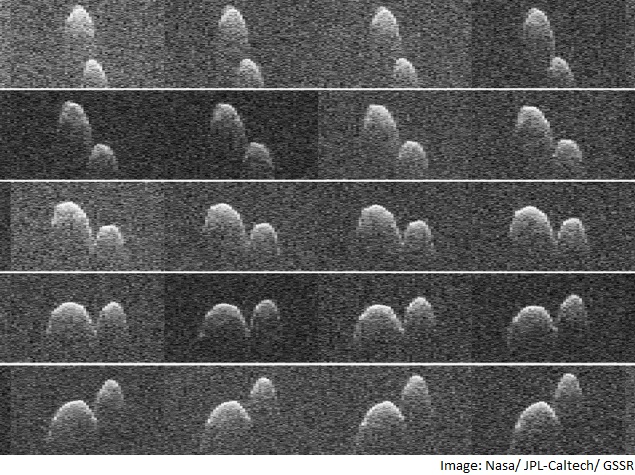- Home
- Science
- Science News
- Nasa Captures Earth Flyby of 'Space Peanut'
Nasa Captures Earth Flyby of 'Space Peanut'

The asteroid named 1999 JD6 appears to be a contact binary - an asteroid with two lobes that are stuck together.
On July 24, the asteroid made its closest approach to Earth at a distance of about 7.2 million kms, or about 19 times the distance from Earth to the moon.
"Radar imaging has shown that about 15 percent of near-Earth asteroids larger than 600 feet, including 1999 JD6, have this sort of lobed, peanut shape," said Lance Benner of Nasa's Jet Propulsion Laboratory in Pasadena, California, in a statement.
To obtain the views, researchers paired Nasa's Deep Space Network antenna at Goldstone, California with the National Science Foundation Green Bank Telescope in West Virginia.
The images show the asteroid is highly elongated, with a length of approximately two kms on its long axis.
Nasa's asteroid-tracking mission places a high priority on tracking asteroids and protecting our home planet from them.
Last week, Nasa said its Mars Reconnaissance Orbiter (MRO) is preparing for the arrival of Nasa's next Mars lander called InSight next year, with its biggest orbit manoeuvre since 2006.
On Wednesday, the Mars orbiter was engaged in a 77-second firing of six intermediate-size thrusters to adjust the orbit timing of the veteran spacecraft.
The move will put the orbiter in position to receive radio transmissions from InSight as the newcomer descends through the Martian atmosphere and touches down on September 28 next year, the US space agency said in a statement.
Written with inputs from IANS
Catch the latest from the Consumer Electronics Show on Gadgets 360, at our CES 2026 hub.
Related Stories
- Samsung Galaxy Unpacked 2025
- ChatGPT
- Redmi Note 14 Pro+
- iPhone 16
- Apple Vision Pro
- Oneplus 12
- OnePlus Nord CE 3 Lite 5G
- iPhone 13
- Xiaomi 14 Pro
- Oppo Find N3
- Tecno Spark Go (2023)
- Realme V30
- Best Phones Under 25000
- Samsung Galaxy S24 Series
- Cryptocurrency
- iQoo 12
- Samsung Galaxy S24 Ultra
- Giottus
- Samsung Galaxy Z Flip 5
- Apple 'Scary Fast'
- Housefull 5
- GoPro Hero 12 Black Review
- Invincible Season 2
- JioGlass
- HD Ready TV
- Laptop Under 50000
- Smartwatch Under 10000
- Latest Mobile Phones
- Compare Phones
- OPPO Reno 15 Pro Max
- Honor Win RT
- Honor Win
- Xiaomi 17 Ultra Leica Edition
- Xiaomi 17 Ultra
- Huawei Nova 15
- Huawei Nova 15 Pro
- Huawei Nova 15 Ultra
- Asus ProArt P16
- MacBook Pro 14-inch (M5, 2025)
- OPPO Pad Air 5
- Huawei MatePad 11.5 (2026)
- Xiaomi Watch 5
- Huawei Watch 10th Anniversary Edition
- Acerpure Nitro Z Series 100-inch QLED TV
- Samsung 43 Inch LED Ultra HD (4K) Smart TV (UA43UE81AFULXL)
- Asus ROG Ally
- Nintendo Switch Lite
- Haier 1.6 Ton 5 Star Inverter Split AC (HSU19G-MZAID5BN-INV)
- Haier 1.6 Ton 5 Star Inverter Split AC (HSU19G-MZAIM5BN-INV)

















